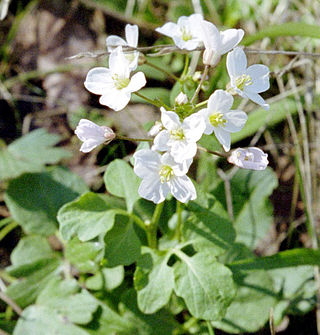
Fumarioideae is a subfamily of the family Papaveraceae. It was formerly treated as a separate family, the Fumariaceae. It consists of about 575 species of herbaceous plants in 20 genera, native to the Northern Hemisphere and South Africa. The largest genus is Corydalis.

Dicentra, known as bleeding-hearts, is a genus of eight species of herbaceous plants with oddly shaped flowers and finely divided leaves, native to eastern Asia and North America.

The Papaveraceae are an economically important family of about 42 genera and approximately 775 known species of flowering plants in the order Ranunculales, informally known as the poppy family. The family is cosmopolitan, occurring in temperate and subtropical climates, but almost unknown in the tropics. Most are herbaceous plants, but a few are shrubs and small trees. The family currently includes two groups that have been considered to be separate families: Fumariaceae and Pteridophyllaceae.

Cardamine californica, or milkmaids, is a flowering plant in the family Brassicaceae, native to western North America from Washington to California and Baja California. It is common in a variety of habitats including shady slopes, open woodlands, chaparral and grasslands in the winter and early spring. In the San Francisco Bay Area, it is one of the first wildflowers to bloom, with blossoms from January to May.

Dicentra cucullaria, Dutchman's britches, or Dutchman's breeches, is a perennial herbaceous plant, native to rich woods of eastern North America, with a disjunct population in the Columbia Basin.

Dicentra formosa is a flowering plant with fern-like leaves and an inflorescence of drooping pink, purple, yellow or cream flowers native to the Pacific Coast of North America.

Corydalis aurea is a flowering plant in the poppy family (Papaveraceae), native to North America. A winter annual, it can be found in such areas as the sagebrush steppe.

Dicentra nevadensis, the Sierra bleeding heart or Tulare County bleeding heart, is a perennial plant endemic to gravelly outcroppings in the Sierra Nevada peaks of Tulare and Fresno Counties in California.

Dicentra pauciflora is a species of flowering plant in Dicentra, the genus containing the bleeding-hearts. Its common names include shorthorn steer's head and few-flowered bleeding-heart. This perennial wildflower is native to the US states of Oregon and California, where it grows high in the mountains in gravelly soils. This is a short bleeding-heart, approaching 10 centimeters in maximum height. From a rhizome beneath the soil it extends several erect petioles, each holding a leaf divided into leaflets which are each divided into smooth, fingerlike lobes. It also erects a thin stem which is topped with an inflorescence of one to three nodding flowers. Each flower is a shade of pink or purple to white, with two curving outer petals flexed back against the flower, and inner petals extended straight outward. The fruit is a capsule just over a centimeter long. The specific epithet pauciflora, refers to the Latin term for 'few flowered'.

Dicentra uniflora, the longhorn steer's head, is a herbaceous perennial growing from a tuber, native to gravelly soils in mountains of the western United States.

Dicentra eximia is a flowering plant with fernlike leaves and oddly shaped flowers native to the Appalachian Mountains. It is similar to the Pacific bleeding-heart, which grows on the Pacific Coast. Dicentra eximia is a perennial herb in the Papaveraceae family.

Aquilegia chrysantha, the golden columbine, is a perennial herbaceous plant native to the southwestern United States from extreme southern Utah to Texas and northwestern Mexico.

Ehrendorferia ochroleuca, commonly known as white eardrops or yellow bleeding-heart, is a biennial or perennial, native to gravelly areas in the chaparral and woodlands of California and in Baja California.

Ehrendorferia (eardrops) is a genus of two species of biennial or perennial herbaceous plants native to wildfire-prone areas of California and the Baja California peninsula. It was named after the Austrian botanist Friedrich Ehrendorfer on the occasion of his 70th birthday.

Dicentra peregrina is a herbaceous perennial growing from a rhizome, native to mountains in Japan and nearby areas of East Asia.

Ichtyoselmis macrantha is the only species in the genus Ichtyoselmis. It is a perennial plant growing from a long rhizome, native to woodland and glades at elevations of 1,500–2,700 metres (4,900–8,900 ft) in northern Burma and southern China.

Dactylicapnos is a genus of frost-tender perennial or annual climbers native to the Himalayas, northern Burma, central southern China, and northern Vietnam.

Vancouveria chrysantha is a species of flowering plant in the barberry family known by the common names golden inside-out flower and Siskiyou inside-out flower.

Viola ocellata is a species of violet known by the common names pinto violet, two-eyed violet, and western heart's ease. It is native to southern Oregon and northern and central California, where it occurs in the coastal foothills and mountain ranges. It sometimes grows in serpentine soils and in quicksilver mines.

Diuris chrysantha, commonly known as granite donkey orchid, is a species of orchid that is endemic to eastern Australia. It has one or two leaves and up to seven deep golden to orange-coloured flowers with brown markings and occurs on the ranges and tablelands north from Tamworth to the Darling Downs.




















